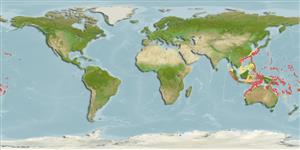>
Eupercaria/misc (Various families in series Eupercaria) >
Lutjanidae (Snappers) > Etelinae
Etymology: Pristipomoides: Greek, pristis = saw + Greek, poma, -atos = cover, operculum + Greek, oides = similar to (Ref. 45335).
Environment: milieu / climate zone / depth range / distribution range
Ecología
marino asociado a arrecife; rango de profundidad 90 - 360 m (Ref. 86942). Tropical; 31°N - 28°S, 93°E - 166°W (Ref. 55)
Distribución
Países | Áreas FAO | Ecosistemas | Ocurrencias, apariciones | Point map | Introducciones | Faunafri
Pacific Ocean: southeastern Asia to Tahiti, north to the Ryukyu Islands, south to northeast Australia.
Tamaño / Peso / Age
Maturity: Lm ? range ? - ? cm
Max length : 76.6 cm FL macho / no sexado; (Ref. 107958); common length : 35.0 cm SL macho / no sexado; (Ref. 9821); peso máximo publicado: 3.0 kg (Ref. 125599)
Espinas dorsales (total): 10; Radios blandos dorsales (total): 12; Espinas anales 3; Radios blandos anales: 8. Interorbital space flat. Lower jaw slightly protruding. Bases of dorsal and anal fins without scales, their last soft rays extended into short filaments. Pectoral fins long, reaching level of anus. Scale rows on back running parallel to lateral line. Back and upper sides pale lavender or pinkish, grading to silvery ventrally. Head with dark spots on top. The margin of the dorsal fin yellow when fresh.
Adults occur over rocky bottoms; off Guam, caught most abundantly between 180-270 m (Ref. 9821). They feed primarily on benthic fishes and to a lesser extent on crustaceans, squids, and pelagic tunicates. Marketed mainly fresh.
Life cycle and mating behavior
Madurez | Reproducción | Puesta | Huevos | Fecundidad | Larva
Allen, G.R., 1985. FAO Species Catalogue. Vol. 6. Snappers of the world. An annotated and illustrated catalogue of lutjanid species known to date. FAO Fish. Synop. 125(6):208 p. Rome: FAO. (Ref. 55)
IUCN Red List Status (Ref. 130435)
Threat to humans
Harmless
Human uses
Pesquerías: muy comercial
Más información
ReferenciasAcuiculturaPerfil de acuiculturaRazasGenéticaElectrophoresesheritabilidadEnfermedadesProcesamientoNutrientsMass conversion
Herramientas
Special reports
Download XML
Fuentes de Internet
Estimates based on models
Preferred temperature (Ref.
123201): 14.8 - 23.1, mean 19.3 °C (based on 136 cells).
Phylogenetic diversity index (Ref.
82804): PD
50 = 0.5005 [Uniqueness, from 0.5 = low to 2.0 = high].
Bayesian length-weight: a=0.01479 (0.01109 - 0.01973), b=2.95 (2.90 - 3.00), in cm total length, based on LWR estimates for this species (Ref.
93245).
Nivel trófico (Ref.
69278): 3.6 ±0.51 se; based on food items.
Resiliencia (Ref.
120179): Medio, población duplicada en un tiempo mínimo de 1.4-4.4 años (K=0.27-0.36).
Fishing Vulnerability (Ref.
59153): Moderate vulnerability (39 of 100).
Nutrients (Ref.
124155): Calcium = 33.9 [19.9, 60.9] mg/100g; Iron = 0.538 [0.290, 0.888] mg/100g; Protein = 18.9 [17.0, 20.6] %; Omega3 = 0.169 [0.111, 0.268] g/100g; Selenium = 51.8 [32.2, 89.0] μg/100g; VitaminA = 64.6 [22.4, 199.4] μg/100g; Zinc = 0.966 [0.694, 1.360] mg/100g (wet weight);
